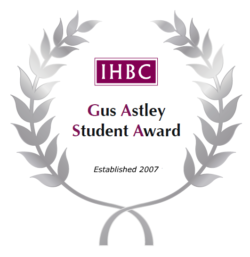 The winners of the IHBC Gus Astley Student Awards for 2023, overseen by guest judge John Fidler – a founder member of the IHBC’s predecessor, the Association of Conservation Officers, and first editor of Context, and now retired from his international consultancy – with all winners offered free places at the IHBC’s Annual School in Reading 12-15 June – #IHBCReading2024, on ‘Place & Building Care: Finance, policy & people in conservation practice’ – in addition to cash prizes, up to £500.
The winners of the IHBC Gus Astley Student Awards for 2023, overseen by guest judge John Fidler – a founder member of the IHBC’s predecessor, the Association of Conservation Officers, and first editor of Context, and now retired from his international consultancy – with all winners offered free places at the IHBC’s Annual School in Reading 12-15 June – #IHBCReading2024, on ‘Place & Building Care: Finance, policy & people in conservation practice’ – in addition to cash prizes, up to £500.
See more on #IHBCReading2024, or simply secure your Virtual Day School place
including event recording (from £30+VAT) HERE
Our CREATIVE Conservation Fund
helps conservation people
DONATE HERE
… a great vehicle for encouraging both current and recent students, fledgling practitioners, and career-changers…
John Fidler, guest Judge for this year, said: ‘I would like to thank the Institute of Historic Building Conservation for the invitation to judge the prestigious 2023 Gus Astley Student Awards.’
‘Gus Astley was a key figure in the founding and development of the Institute and although no longer with us, he continues to influence the organisation through the farsighted fund that bore his name and is now incorporated in the IHBC’s CREATIVE Conservation Fund. This continues to foster interest among and scholarship within potential and newcomer Institute members from the UK student body.’
‘The annual awards are a great vehicle for encouraging both current and recent students, fledgling practitioners, and career-changers, to reveal their research discoveries about the historic environment and its sustainable management. Such work helps focus and define their vocational pathways ahead, and the awards provide opportunities to link student interests to expert practitioners, perhaps future employers, and collaborators, through the Institute of Historic Building Conservation.’
‘I want to thank IHBC Director Seán O’Reilly, and my old friend and English Heritage colleague Chris Wood (Chair of the IHBC’s Education, Training and Standards Committee) for their arm-twisting, encouragement, and patience. In particular, I should also profusely thank my old Association of Conservation Officers/IHBC colleague, Bob Kindred for steering me through the sieving and sifting process, and especially for providing a modest short list for my deliberations and consideration.’
‘I would like to thank also all entrants for their huge efforts in the course work submitted for the award – not many know that any entrant not already enjoying the benefits of IHBC membership is offered a free ‘taster’ year thanks to the fund!’
‘Most especially though, I would like to congratulate all the winners for this year, whatever their final award, and I look forward to meeting as many of this select group as can make it at the 2024 Annual School Dinner in Reading, on 14 June.’
Bob Kindred, IHBC lead on the Awards and judge on the Booth-Bird Award for Conservation Management Plans or their equivalent said: ‘The importance of Conservation Management Plans in understanding heritage significance is recognised by the Institute through the award of the annual Booth-Bird prize.’
‘Although the methodology is well-understood, assignments to deliver insightful ones are recognised as a challenge for students particularly where the outcome is to balance special architectural or historic interest with imaginative adaptation and reuse.’
‘The CMP by Hannah Beaman fulfilled this task admirably and was a clear choice for this year’s prize.’
IHBC STUDENT AWARD WINNERS 2023
IHBC Gus Astley Student Awards
Thomas Goodwin, of Oxford Brookes University and the University of Oxford, has taken the top award with a prize of £500 for his dissertation ‘Using ye Founder Kindly: Restoring, razing, and rebuilding historic buildings in early modern England (1660-1740).’
Thomas’ tutor David Lewis said: ‘With this essay, Tom achieved one of the most difficult acts of scholarship, shining new light on familiar material. I am delighted to hear that the IHBC has recognised his work with such a prestigious prize.’
Thomas said: ‘I am delighted to have been awarded the Gus Astley Student Award for 2023 and look forward to attending the IHBC Annual School in Reading later this year. I would like to extend my gratitude to the IHBC, the Gus Astley Memorial Fund, now part of IHBC’s CREATIVE Conservation Fund, and the guest judge John Fidler. I am also thankful for the support and knowledge of the staff on the MSc in Historic Conservation at Oxford Brookes and the University of Oxford. The insight and constant encouragement of my supervisor, David Lewis, was particularly valuable.’
‘My project examined the history of conservation from 1660 to 1740, connecting emerging conservationist sensibilities in British architectural culture to changes in the theory and practice of architecture. It is surprising just how many enduring values and approaches pioneered in this period there have been. In the course of my research, I encountered everything from statements about the desirability of consciously adopting a contextual approach to design in historic settings, to a concerted campaign to preserve the best architecture of the recent past, in this case, the works of Inigo Jones.’
Hannah Daniels, of Cardiff University, received a Highly Commended award of £250 for her dissertation ‘The Valorisation and Sustainable Reuse of West Midlands Hop Kilns.’
Hannah’s Course Director, Dr Chris Whitman, said: ‘The Welsh School of Architecture congratulates Hannah on her commendation. Her dissertation is a well-illustrated and engaging dissertation that takes a clearly defined topic, and through it explores wider questions of value, authenticity, and the impact of adaptive reuse on significance. The research is rigorous, with appropriate methodologies selected, which are implemented to a high standard. Given that the author’s undergraduate qualifications are not in the field of architecture, surveying or building conservation, the work presented demonstrates an exceptionally high degree of learning obtained through the study on our MSc Sustainable Building Conservation.’
Hannah said: ‘I am delighted to have received a commendation from the IHBC for my dissertation on the valorisation and sustainable reuse of hop kilns in the West Midlands. I am honoured that the my dissertation has been judged to be worthy of this wider recognition. Every ‘Masters’ student strives for their dissertation to be impactful, and there are few opportunities for this without actively aiming to become published.’
‘I am particularly grateful to my tutor Bruce Induni for his constant enthusiasm in my subject of study, as well as my coursemates, who were invaluable for bouncing ideas around.’
Maria-Elena Calderon, of the University of Central Lancashire, received a Highly Commended award and £250 for her dissertation ‘Traditional Surface Finishes of Vernacular Buildings – a perspective from the N. York Moors’.
Maria’s tutor, Christopher O’Flaherty, said: ‘I’m delighted that Maria has been commended for her work. It’s a very valuable and excellent piece of research, which could be replicated across the country to help explore evidence of vernacular building practises. Maria encountered numerous challenges in conducting the research, but conquered these with perseverance and ingenuity, always mindful of the need to scrutinise the reliability of evidence.’
Maria said: ‘Researching the precedence of historic surface finishes (e.g. render, limewash, etc.) has completely changed how I view traditional masonry. I’m increasingly convinced this unsung hero will be a crucial implement in the adaptation toolbox as we prepare our traditional buildings to be climate resilient. It was sobering to realise that even after decades, if not centuries, of conservation practice and philosophy, our traditional buildings still have much to teach us. I appreciate that the aesthetic of exposed stone masonry is still highly valued by the general public and within some conservation circles. Recognition by the IHBC for this work means more to me than my grade. It demonstrates that the small but growing number of us who identify that many surface finishes have been lost are on to something. I want to thank my friends, former colleagues at the North York Moors, and husband for all their support and for suffering my pontificating, the eruption of books and notes about the house and my inability to walk past a traditional building without spending at least 5 minutes looking for trace evidence of historic surface finishes.’
IHBC Booth-Bird Student Award for a Conservation Management Plan or equivalent
Hannah Beaman, of Birmingham City University, has been awarded £150 and the Booth-Bird Prize – awarded for a Conservation Management Plan (CMP) or equivalent – for ‘St. James’, Eve Hill, Dudley -The Sustainable Reuse of a Place of Worship’.
Course Director, and Hannah’s tutor, Katriona Byrne, said: ‘I am delighted that one of our students Hannah Beaman has won this prize for her second year Viability Project. Places of worship are the focus of this assignment, both as a typology that is very important to our cultural landscape and one particularly at risk. Hannah chose St James’ Church, a Grade I listed church built in 1840 to serve the rapidly-expanding population of Dudley in the Black Country, and enlarged just 28 years later as the congregation continued to grow. In the present day however a more multicultural local profile, and a national decline in church attendance, has left a congregation of around 15 worshippers, struggling to run the building and facing an overall repair bill of around £1.5 million.’
‘These conversations are always difficult but Hannah’s report identified a viable and sustainable way forward through rigorous analysis of the building, its context, and the needs of the local community. It outlined a series of options, before proposing a strategy of adaptive reuse, with the creation of a community combat-based gym facility and supporting café.’
‘From the course Hannah was employed as a conservation architect with Donald Insall’s in Birmingham and her report is helping the West Midlands Historic Buildings Trust pave the way for a future for this church.’
Hannah said: ‘I am honoured to have been awarded the Booth Bird Prize in this year’s Gus Astley Student awards for my report identifying a potential future for St James’ Church in Dudley.’
‘This assignment was quite a challenge, as it quickly became apparent that St. James was unlikely to be sustainable solely as a place of worship. What therefore do you do with such a large building, that is inefficient and costly to run, in need of extensive repair and within an area of high social deprivation? Identifying a workable solution involved careful analysis of not only the church itself, but the local area, and social profile. The hope is that the end solution has the ability not only to breathe new life into the former church, but to see the building emerge as a catalyst for wider change, with the creation of a positive, accessible and much-needed facility for the local community, that is viable in the long term.’
‘I would like to thank my tutors at Birmingham City University for all their support and encouragement throughout the Conservation of the Historic Environment course, and my colleagues at Donald Insall Associates, with whom I am privileged to be putting these skills into practice, caring for and breathing new life into historic buildings.’
See more on the Gus Astley Student Award, with the next round of online submissions of relevant course work closing on 31 August 2024.
See more background to the previous Awards.
See more on submitting online
See more on the IHBC’s 2024 Reading School HERE and the Institute’s regular Annual Schools HERE
See more on and donate to the IHBC’s CREATIVE Conservation Fund: Supporting conservation people


